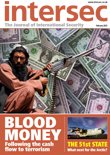Numbers game
Uri Guterman reports on how advances in ANPR are changing security
Drivers travelling along UK motorways in 1979 were likely unaware that they were becoming part of history. This is where the first ANPR (automatic number plate recognition) cameras were deployed, before being rolled out more widely in the Eighties. In 1981, the technology was first credited for arresting a vehicle thief in the UK.
Since then, ANPR has become a key tool in global policing and security teams’ arsenal to secure our streets and buildings, and to protect us from crime and terrorism. After all, there are almost 39-million vehicles in the UK and 278-million in the US, which would be humanly impossible to monitor and protect without the aid of ANPR.
With advances in artificial intelligence, ANPR is set to become even more integral to protecting our buildings and streets with make, model, colour and vehicle type recognition (known as MMCR). High-speed ANPR, detecting number plates at speeds up to 200kph (124mph) across two lanes of traffic is now also possible with the latest ANPR camera launches. In fact, in a recent test conducted at a racing track in France, a Hanwha Vision high-speed, MMCR solution successfully identified sports cars being driven at speeds of up to 265kph, even at night.
In general terms, ANPR cameras can detect or be used to detect, identify, and monitor: the average speed of a vehicle; bus lanes and box junctions for unauthorised vehicles; parking in car parks, including integrating with ticket management for seamless entry/exit; access to restricted areas for pre-authorised vehicles; toll road access; congestion zones; traffic journey times; identifying vehicles involved in accidents; untaxed or uninsured vehicles; stolen vehicles; and potential evidence as part of major and organised crime. ANPR also works at night, and in dark environments like tunnels, due to their powerful infrared illuminators. This gives it a huge range of applications for security and policing.
ANPR has become prolific in helping law enforcement authorities deter and detect crime. This involves anything from identifying uninsured and untaxed vehicles, to locating stolen vehicles, detecting erratic and unsafe driving, and providing evidence against organised crime.
For security leaders, ANPR is helping to secure buildings and sites against unauthorised access, integrating with access control and parking systems, and providing insights on road and car park usage. ANPR is commonly found in retail and commercial car parks, restricted areas like ports or logistics centres, council waste sites, education establishments and more.
In smart cities, ANPR can reduce congestion and help with vehicle accident response times. The average speed of vehicles can also be determined with two cameras in a set position. This can help with traffic infringements (with fines automatically issued to registered addresses) and also alert city leaders if a particular route is prone to speeding violations. They can then take mitigating actions like putting in speed bumps or closing a route at specific times of the day. Overall, ANPR is helping to make our buildings, roads, and cities safer, more efficient, and nicer to experience.
Of course, some of these uses are more advanced than others and the applications of ANPR really depend on the innovation of the implementing team. Today’s ANPR solutions are advanced enough to deliver benefits far beyond traditional security, including business intelligence, operations, site and building management and more. Integrating with wider camera surveillance systems can provide further insights and analytics.
AI is now taking ANPR to the next level with make, model, colour, and vehicle type recognition. Giving crucial contextual insights for police investigations, control rooms, business intelligence and future planning.
Footage with make, model, colour and type recognition can help to corroborate or disprove eyewitness accounts which can be inaccurate or incomplete, particularly in regard to vehicle licence plates. Being able to search video footage by make, model, and colour can help investigators find vehicles of interest faster. It removes some of the frustration and time needed to identify or sometimes even locate vehicles involved in an incident.
Likewise, MMCR can be used to accurately identify vehicles involved in traffic infringements such as speeding or dangerous driving. Vitally, if a large vehicle like a lorry mistakenly enters a restricted route where there is a risk to the vehicle and those nearby, operators can be quickly alerted and proactively try to contact the driver before their mistake results in an accident or road blockage. Integrating with digital signage and Tannoy systems can support this, allowing automated reminders of size/road restrictions or direct messages from operators to be relayed quickly to drivers.
Even where a route isn’t restricted, this contextual information about the size and types of vehicles can help city planners to understand where roads will require more maintenance due to increased wear and tear. They can also limit access to some areas where heavy vehicles may cause expensive damage to roads. Peak traffic reports can aid with smart traffic management, by reporting on the quantity and type of visiting vehicles in an area, peak hours, duration of stay and seasonality.
Criminal gangs will often try to work around ANPR detection by swapping licence number plates. With make, model, and colour search criteria, police forces can cross-reference stolen vehicle reports to better combat this tactic. Make, model, and colour recognition can also help with vehicle cloning when linked with other, national security systems to assist with high-level security alerts. For example, if roads need to be locked down for state visits or in a possible terrorist situation.
Make, model, and colour recognition can also improve parking management, by tailoring services to specific vehicle types. A driver in a detected electric vehicle, for instance, can be guided to the nearest charging station automatically when the ANPR integrates with digital signs and audio. Pre-authorised vehicles can gain automatic access to a car park, with VIP vehicles directed to VIP parking areas. ANPR data can support parking management and planning, for instance, in designing future car parks and parking space allocations.
Similarly, at toll stations, vehicles can be automatically charged based on their detected type, cutting down on the time needed to wait at paying stations and improving traffic flow. It also reduces manual ticket and cash collection, therefore eliminating possible human error.
The data collected from these ANPR cameras can give insights into the types of vehicles using toll services. This can help with resource allocation at certain times of day, maintenance schedules, and delivering other services.
On a citywide level, vehicle-type recognition can give city leaders a greater understanding of road usage. ANPR data can support surveys that look into whether a road needs to be widened, additional routes through an area developed or to understand the potential impact of new bus and cycle lanes. Where heavy vehicles are often identified as passing through, roads can be reinforced to proactively reduce damage or weight restrictions can be implemented.
These insights will also help with the development of electric vehicle charging infrastructure. Something that’s likely on many city planners’ minds given the net zero targets that many cities, including London, Copenhagen, Los Angeles, Toronto and Sydney are committing to. ANPR data can help planners make more informed decisions around sustainable transport planning, including congestion zones.
With make, model, colour, and type ANPR, vehicles can be classified into seven different types: cars, SUVs, vans, light commercial vehicles, trucks, buses or motorcycles. Deep learning (a type of AI) algorithms recognise the brand, model, and colour of a detected vehicle. The TNO-7180RLP high-speed ANPR camera by Hanwha Vision, for instance, can detect 70 different automotive brands, 600 models, and 10 colours — from different regions including Europe and the UK, Canada, the US, Australia and New Zealand, Vietnam, Indonesia, the Middle East, South Africa, and Russia.
Deep learning is crucial to make, model, colour and type detection by giving contextual insights to operators, assisting with investigations, rapid forensic search of video footage, and more. All with peace of mind that the deep learning model has been trained on enough data to give accurate results.
With deep learning, the algorithm learns from examples. During an initial training phase, it is supplied with large amounts of data representing correctly solved examples of the challenge at hand. After this training, the algorithm can be put to work with an accuracy of approximately 98 percent, which is about the same as the ability of human beings to do the same thing.
Unlike its human counterparts, the algorithm can constantly be analysing ANPR footage, 24/7/365, without tiring or having to take a break. That’s what makes it so valuable to security and policing teams that need to continuously monitor roads, parking sites, buildings and restricted areas.
Although the ANPR camera itself is valuable to security teams, as part of a wider surveillance installation greater efficiencies and insights can be gleaned. Especially when video analytics is carried out on devices themselves, known as AI at the edge. High-quality IP cameras can provide opportunities to analyse traffic data on the camera itself, saving a huge amount of resources. AI at the edge can also save on server needs by sending data back to the cloud, as well as saving the time needed to trigger an event. Combining ANPR cameras with IP cameras equipped with edge AI can really prove a game-changer for security teams looking for scalability, accuracy, and rapid response times.
As the benefits of ANPR are realised by all parts of an organisation, so too will its scope. Going from the mainstay of policing and security to becoming a key part of city and site planning, improving the driver experience, and influencing city infrastructure. The next step I foresee is the integration with IoT and the analysis and interpretation of big road traffic data generated by ANPR and other AI cameras and sensors. This will generate invaluable information for cities, police and other economic industries, but that’s another story for another day…
Uri Guterman is Head of Product & Marketing at Hanwha Vision Europe.







